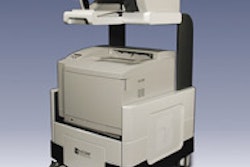CHICAGO - Women with a genetic predisposition for breast cancer would still benefit from additional screening with ultrasound, regardless of their breast density, according to investigators from Canada.
They found that in a high-risk population, ultrasound screening is worthwhile for women with a breast density of more than 50%. However, even in women with less-dense breasts, cancer may remain mammographically occult, again warranting ultrasound screening.
Women who are BRCA gene carriers or have a family history of breast cancer, and do not elect to undergo prophylactic mastectomy, have an 85% risk of developing the disease by age 70, said Dr. Colm Boylan during a presentation Monday at the RSNA meeting.
Boylan is from Sunnybrook and Women's College Health Sciences Centre and the University of Toronto in Ontario, Canada. One of Boylan's co-authors is Dr. Ellen Warner, a noted researcher in the field of MRI screening for women with a genetic risk for breast cancer.
Current National Comprehensive Cancer Network Consortium recommendations for tracking these at-risk patients consist of monthly clinical breast exam, breast self-exam, and annual mammography commencing between 25 and 35 years.
"Evidence suggests that this regimen is suboptimal for the detection of cancer (in these women), with 50% of patients presenting with integral cancers and 40% to 70% having tumors that exceed 1 cm in diameter at diagnosis," Boylan said.
The group set out to determine if mammographic breast density is an appropriate indication for recommending screening breast ultrasound in BRCA1 and BRCA2 mutation carriers, or those with a family history.
Their study population consisted of 437 women who underwent 1,202 rounds of screening with mammography, ultrasound, MRI, and clinical breast exam (CBE). Of these 437, 171 were BRCA1 carriers, 147 were BRCA2 carriers, and 119 had a strong family history. The screening mammograms were categorized according to the following criteria: overall breast density, breast density in the region of the cancer, correlating film-screen with ultrasound, and whether the cancer could be identified retrospectively on mammography.
The patient population for this study was a subgroup of a larger, five-year trial led by Warner and colleagues. The group recently published a paper stating that, in BRCA1 and BRCA2 mutation carriers, MRI is more sensitive for detecting breast cancers than mammography, ultrasound, or CBE alone (Journal of the American Medical Association, September 15, 2004, Vol. 292:11, pp. 1317-1325).
According to the results, 36 cancers were detected with screening, with 27 cases of invasive cancer with an average diameter of 1.1 cm. Four had positive axial lymph nodes, and there were nine cases of ductal carcinoma in situ (DCIS).
Of these, 15 cancers were detected with ultrasound, and eight of them were mammographically occult, Boylan said. "Interestingly, one of these cancers was detected only by ultrasound, and this was an invasive lobular cancer," he added. However, there were no cases of DCIS found with ultrasound alone.
"We assessed the overall mammographic breast density of the cases, and we found that it was scattered fibroglandular density in three (true-positive) cases, heterogenous density in six (true-positive) cases," Boylan explained. "When we looked at the local mammographic breast density in the area of the cancer, we found that it was predominantly fatty in one case, scattered fibroglandular density in one case, heterogenous density in four cases, and very dense in two cases." In terms of background echo texture, the group found that the majority of cases were homogenous glandular.
"When we assessed these screening mammograms to see whether any of these tumors were visible in retrospect, we found that where the local mammographic breast density was fatty, the tumor was not visible because it was outside the field of the screening mammograms," Boylan continued. "In the case where the local breast mammographic breast density was scattered, we could see the tumor in retrospect. In the other cases, the tumors were not visible in retrospect."
In this population, breast cancer is more likely to be missed with mammography when the breasts are heterogenously dense, the researchers concluded. Screening mammography was unsuccessful in a small number of cases in which breasts have scattered fibroglandular density, which is likely the result of a failure to image the area, or a failure to observe the abnormality rather than technique, Boylan said.
They advised against using mammographic breast density as a basis for excluding high-risk patients from ultrasound screening.
By Shalmali Pal
AuntMinnie.com staff writer
November 30, 2004
Related Reading
MRI best for women with heredity risk of breast cancer, September 14, 2004
MRI breast cancer test benefits high-risk women, July 29, 2004
Annual breast cancer screening may not suffice for BRCA-positive women, April 12, 2004
Copyright © 2004 AuntMinnie.com



















